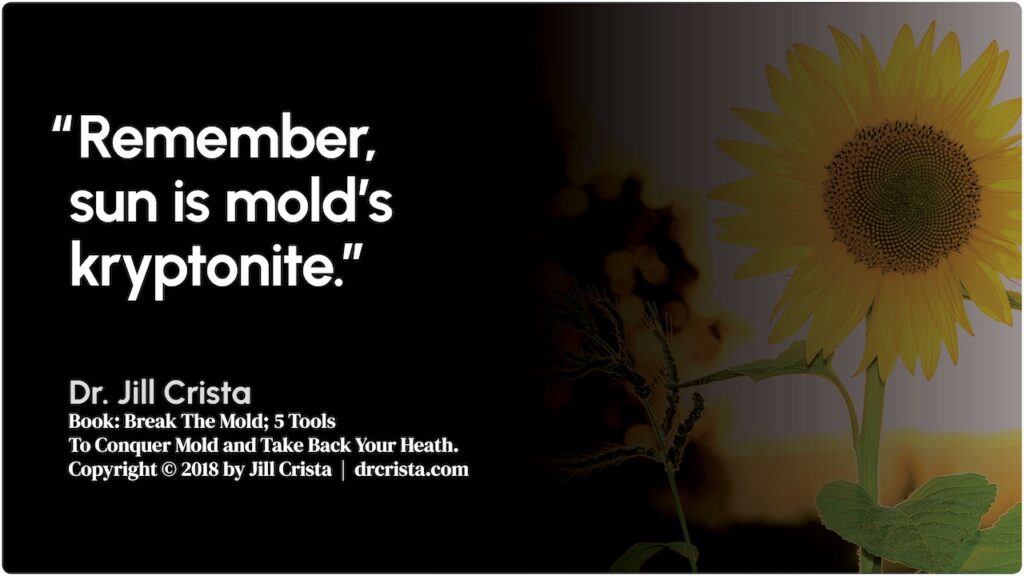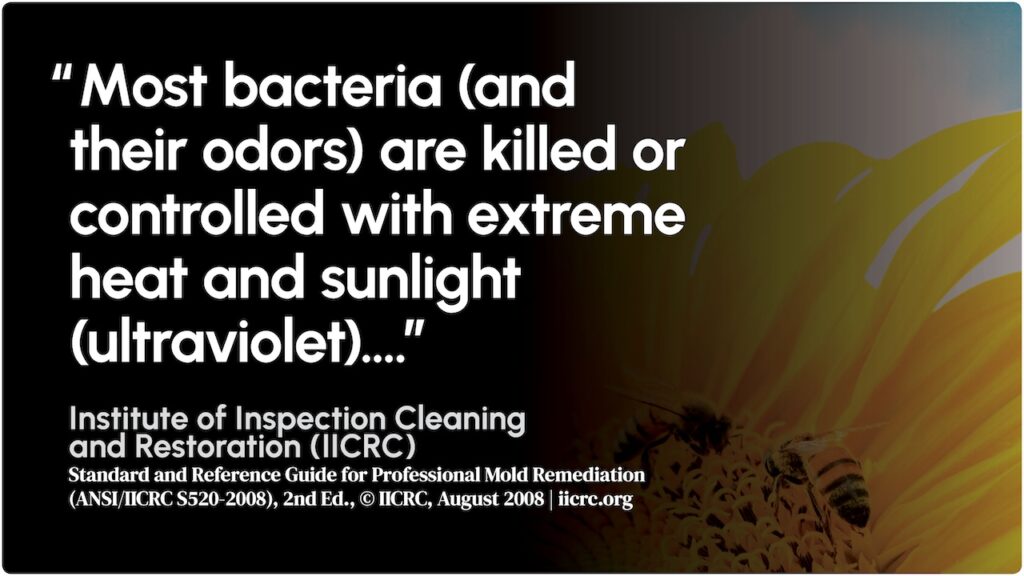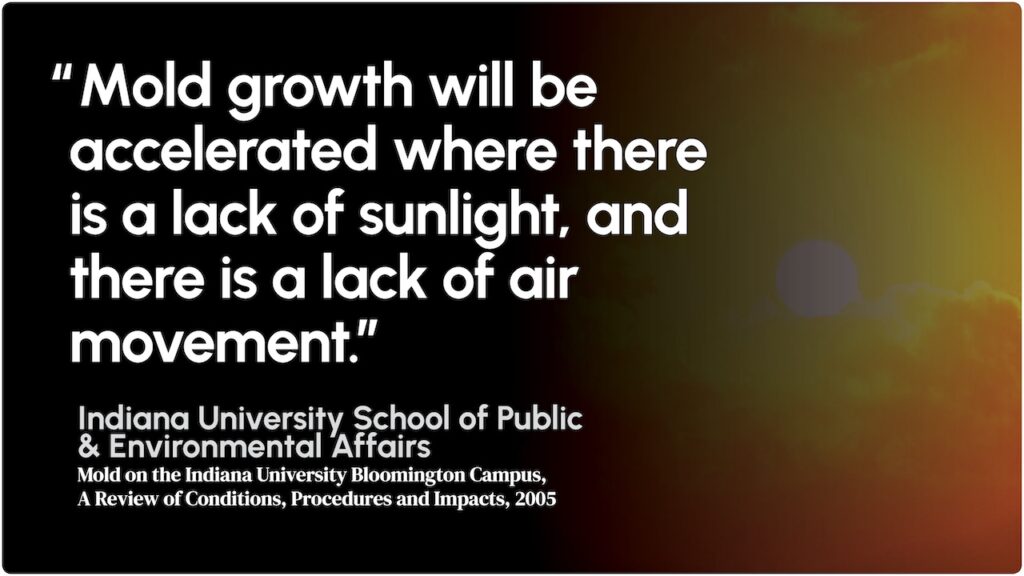How Sunshine and Sunlight Kill Mold

“Remember, sun is mold’s kryptonite.”
That’s the next-to-last closing line of what’s probably one of the best books on mold as it affects the human body, “Break the Mold,” by Dr. Jill Crista.
Early in the book, Dr. Crista explains that, “The sun provides two mold-fighting aspects, UV light and vitamin D.
“UV light from the sun is mold’s kryptonite,” she writes.
The vitamin D in this power duo applies to bodies, while the UV light in it applies to both bodies and buildings.
Mold is killed by the sun and, conversely, its growth is accelerated by the sun’s absence: Mold grows faster in areas that lack sunlight.
Ultraviolet light from the sun can and does kill mold and as a homeowner or resident, there are ways you can use this to your advantage.
- Place wet or damp items out in the sun to dry.
- Place previously moldy items out in the sun after cleaning them.
- Let sunlight into your home by drawing the curtains.
- Recognize that areas of a home, residence, or building that the sun can’t or doesn’t reach will be more prone to mold growth.
- Recognize that heat generated by the sun will cause moisture to evaporate, and so place wet clothing and other items outside of the home to dry.
- Park vehicles affected by mold growth in the sun to air out and dry out.
Mold typically shows up in the darker and damper parts of buildings, including basements and crawl spaces, attics, inside bathroom cabinetry and vanities, and within a building’s walls whenever moisture is also present.
And it prefers these and other similar areas of the home because of the lack of direct sunlight, and the dampness or moisture in them: Remove the moisture and new mold growth is no longer a problem. (U.S. EPA)
Mold Can Survive Off of ‘Moisture’ Alone
“Moisture” doesn’t have to be as visible as droplets, or a small puddle of water.
Enough invisible moisture might already exist in a room’s air alone to spawn mold growth.
A hygrometer will help you detect a room’s moisture content, and it should be between 30-50 RH, and never over 60 RH (RH = relative humidity).
Where the sun and sunlight exist to bring life, mold ushers in the end of that life.
Between the birth of life and structures, mold spores lurk everywhere, ready and waiting, for the right conditions that signal its time has come and that dead or dying matter needs to be decomposed.
“Waiting” is probably the wrong word: Mold actively seeks out moist areas that are shielded from the sun.
It needs moisture, a food source, 24-48 hours of time, and a lack of direct sunlight in order to survive, and by surviving, it decomposes the organic matter in its path (spewing out toxins in the process).
When The Sun’s Away, the Mold Will Play
The fact that direct UV light from the sun can kill off a mold colony is a big part of why the fungus doesn’t often grow in sunny areas, but it isn’t the only reason.
Another primary factor is the heat the sun generates. Most molds typically flourish in areas that are warm and damp—in fact, the ideal temperature for many species of mold to grow is between about 77 and 86 degrees Fahrenheit. But as it gets hotter, heat alone can hamper the growth of mold.
Another reason that mold doesn’t like to grow in sunlight is that sunshine dries out mold, which needs moisture to grow.
Without moisture, mold spores are unable to survive, and any appreciable amount of time spent in direct sunlight will help moisture evaporate .
Sunlight as Mold Killer

If you have a current mold problem, you may be able to use the sunlight to help you get rid of it. Granted, this is only the case for fairly limited mold growth—sunlight is not a replacement for proper mold remediation.
“Toxic indoor molds can’t survive in UV light from the sun. They wither away in the sunlight like vampires. Sunshine is a mold-fighting resource and it’s free.”
Break the Mold, by Dr. Jill Crista, © 2018
Plus, the fungus has to be growing on a surface that you’ll be able to move into the path of the direct UV rays. For example, if mold is growing on a floormat in your home, you can attempt to kill the spores by taking it outside on a warm, sunny day.
First, though, you’ll want to equip yourself with gloves, goggles, and a facemask, then scrub the mold with a bristled brush and treat it with a mold-killing agent—vinegar, baking soda, or soapy water qualify, but be sure the matt dries out fully before returning it inside.
Drying that matt out in the sun will help handle the mold in it, and the sun can also be used as part of your spot treatment of mold on all other movable items.
(Just be sure the sun won’t also cause the color in the item to fade—books, paintings, and certain brightly colored fabrics may need to be cleared of mold in other ways, or in some cases, disposed of if they don’t hold sentimental value.)
Sunlight as Mold Prevention
“…mold growth will be accelerated where there is a lack of sunlight, and there is a lack of air movement.”
Mold on the Indiana University Bloomington Campus, A Review of Conditions, Procedures and Impacts, 2005
For the most part, the keys to avoiding mold growth in your home are keeping the humidity in check, preventing water leaks, and closely monitoring any damp, dark, and stagnant-air areas of the home.
But there are also ways you can use sunlight to reduce your chances of being affected by mold.
One thing you can do is regularly open up the curtains around your home when the sun is shining.
The UV rays should help decrease the odds of mold appearing in areas where sunlight is shining in, but be sure that the extra heat this generates doesn’t cause your home to become too humid. If it’s a nice day out, consider opening windows or turning on a ceiling fan as well to help reduce stagnant heat and, in turn, humidity.
Another prudent measure you can take is to place household items out in the direct sunlight if they become moist.
If a rug, pillow, pair of shoes, baby stroller, or any other object that you don’t want to run through the dryer gets wet, you can expose it to the UV rays as a proactive measure. The heat and sunlight should be effective at drying it out and keeping any fungus from showing up.
Limits of Sun in Mold Removal, Remediation
Though the sun is a perfectly natural and extremely powerful way to prevent and kill mold, it does have its limits:
- Sunshine won’t replace proper mold remediation if it’s needed.
- Sunshine won’t kill or prevent mold in areas that its light doesn’t directly reach.
- Given the right conditions and enough time, mold may grow even on objects left out only briefly in the sun, or in areas only very briefly exposed to sunlight.
- As the color of some clothes and other items would fade if left out in the sun, not all mold can be treated with sunshine.
- Sunshine is very unlikely to kill all of the mold in an affected couch, teddy bear, pillow, or other plush item of considerable size or depth.
- Unless there are “compelling reasons” not to do so, it is better to throw away and replace some personal belongings affected by mold than it is to try salvaging them. What items fall into which category would depend on the make up of the item (material, size, design, construction, etc.), its intended use and user (an infant?, an elderly man?, or a pregnant woman?) and, most importantly, how sensitive to mold the item’s owner and others in his or her household are.
What to Do — Let There Be Light!
Go out in the sun yourself. Open your curtains and let sun pour into your home or office. Open your windows on days you’re home and the weather isn’t rainy, humid, or muggy—and close them on days it is, and let the A/C run instead to dehumidify. Place moldy items out in the sun after cleaning them, but consider tossing anything that’s porous, plush, or used by children or others who might be immunocompromised, elderly, or pregnant.



